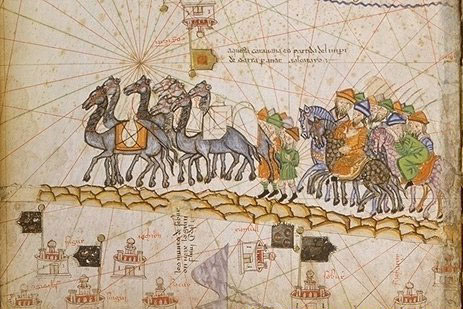New Project seeks World Heritage status for Ancient Silk Road
A major project is underway by China, Kazakhstan and Kyrgyzstan to get dozens of heritage sites established on UNESCO’s World Heritage List, according to a news report in CCTV. The sites are all found along the ancient Silk Road, a series of trade and cultural transmission routes that links the East with the West.
The Silk Road derives its name from the lucrative trade in Chinese silk carried out along its length, beginning during the Han Dynasty more than 2,200 years ago. The route stretches over 10,000 kilometres across more than a dozen countries linking traders, merchants, pilgrims, monks, soldiers, nomads, and urban dwellers from China to the Mediterranean Sea during various periods of time.
According to UNESCO, “the Silk Road had been playing the role of a bridge linking the economies and cultures between the ancient East and West as well as connecting the friendship of China and Eurasia. In the process of its formation and development, the major religions and cultures in the ancient world made plenty of communications, exchanges and amalgamations, which boosted the human being to create splendid and influential civilization and left behind valuable cultural legacy.”

An illustration depicted the Silk Road and some of the goods that were traded. Image source.
Archaeological evidence has revealed that the Silk Road functioned as the main road for migration and communication before the Western Han dynasty (206 BC - 25 AD). However, it wasn’t until the Han dynasty of ancient China that the intentional exchange of knowledge and goods between the different civilizations began.
During the Wei-Jin period (220 – 420 AD), Buddhism was introduced along the Silk Road on a large scale, and in the Northern Dynasties (386 – 581 AD), there was a significant strengthening of the unification tendency appearing in both the east and west ends of the Silk Road. As the powerful empires emerged one after another, the traffic facilities, safety conditions and social order along the Silk Road continually improved, enabling the Silk Road to reach its height of power.
The Silk Road prospered for many centuries until the Yuan dynasty (1279 – 1368 AD) when the society and culture of China came into a stage of long-time adjustment and inward reflection while the world stepped into the process of modernization. During this process, the traditionally classical states gradually went into decline or desegregation. At the same time, the sea trade developed further and weighed more than the overland trade from both importance and scale. However, even in this period, the use of promoting cultural exchange of the Silk Road had not lost completely.

Caravan on the Silk Road (1380 AD). Image source: Wikipedia
Sites along the Silk Road are incredibly diverse and include architecture from various civilizations and religions. Many of these heritage sites have now been put forward for World Heritage protection including 22 sites across 5 provinces in China, 8 heritage sites in Kazakhstan and 3 heritage sites in Kyrgyzstan.
"A trade route so ancient and of this scale has no equal. It connected so many civilizations and is truly special in human history," said Guo Zhan, deputy director of the International council of monuments and sites.
After 1840, China was forced into joining the unfair international order set up by the Western European powers. And the peoples and states along the Silk Road suffered a series of invasions by capitalism powers to different extents. From then on, the Silk Road finished its historical mission finally. Nevertheless, its preservation as an internationally important record of the past is vitally important and acceptance as a World Heritage site would help people better preserve its relics, and further understand its past.
Featured image: Overland on the Ancient Silk Road. Image source.



















